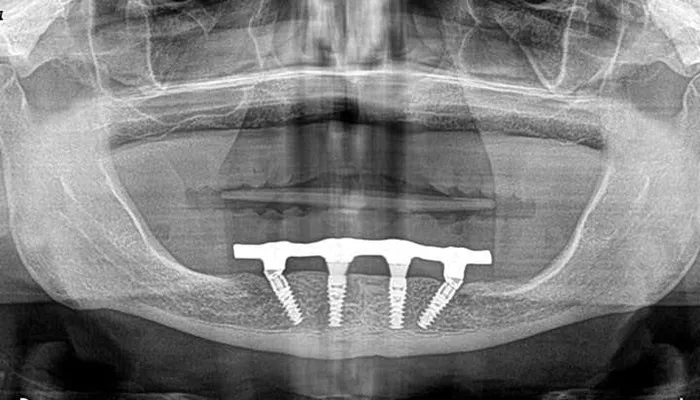Dr. Jurgis Visockis discusses a case study demonstrating the ‘all-on-four’ concept for restoration with dental implants.
The ‘all-on-four’ concept involves placing four implants in fully edentulous jaws to support a fixed, full-arch prosthesis that is immediately loaded. Using both tilted and straight implants for support, this method offers a simpler, quicker, and less costly procedure. It also provides a more comfortable post-surgical period for patients.
Introduction
A 58-year-old man, who had been partially edentulous for a long time due to periodontal disease, was referred to us. He had struggled with various types of prosthetic dentures on his lower jaw. We chose this case because it was complex, involving the removal of the remaining teeth and bone grafting.
The patient requested a fixed prosthetic restoration for his lower jaw. He was tired of using removable dentures.
Case Report
A 58-year-old man was referred by his dentist due to significant problems with his lower denture. The remaining teeth were painful, and the denture was extremely loose. The patient was unable to eat, speak, or perform many daily functions.
Various options were considered, and we decided on four Meisinger implants with multi-units and an immediate implant-retained temporary denture. The distribution of Meisinger implants is crucial for establishing the ‘all-on-four’ principles. After five to six months of healing and implant integration, we planned to place the final screw-retained appliance.
The ‘all-on-four’ technique was scheduled to rehabilitate the lower jaw. Under local anesthesia, the remaining teeth were removed, and the sockets were cleaned. A full-thickness crestal incision was made from the right first molar region to the left first premolar region. A midline releasing incision facilitated flap reflection, and a 2-4 mm osteotomy was made to level the alveolar crest. All sites were prepared using the manufacturer’s guidelines (Meisinger Implants) under copious sterile saline irrigation. A check was done for possible communication between implant sites before implant placement.
Four Meisinger implants were placed in the planned region. After soft tissue management and closure, straight and angulated multi-units were placed onto the implants. A new temporary denture was constructed, allowing it to be securely attached to the implant multi-units.
Five months later, new impressions were taken for the final screw-retained appliance. The patient was delighted with the result and can now eat and function normally with a secure and stable denture.
Restoration Discussion
Recent shifts in practice aim to minimize treatment costs and patient morbidity while providing highly satisfying patient-centered outcomes. The ‘all-on-four’ treatment concept aims to meet these objectives by offering a straightforward and predictable option to rehabilitate edentulous patients, enhancing their quality of life.
In this case, we removed the remaining teeth and leveled the bone crest. Due to sufficient bone thickness distally, we were able to place four axial implants. Most lower jaw restoration cases require placing implants at an angle due to the mental nerve foramen. There are no significant differences between axial and tilted implants in terms of success rates and marginal bone loss.

